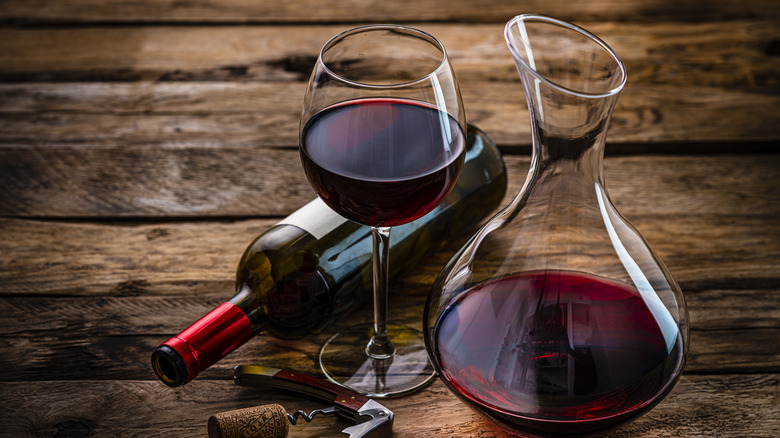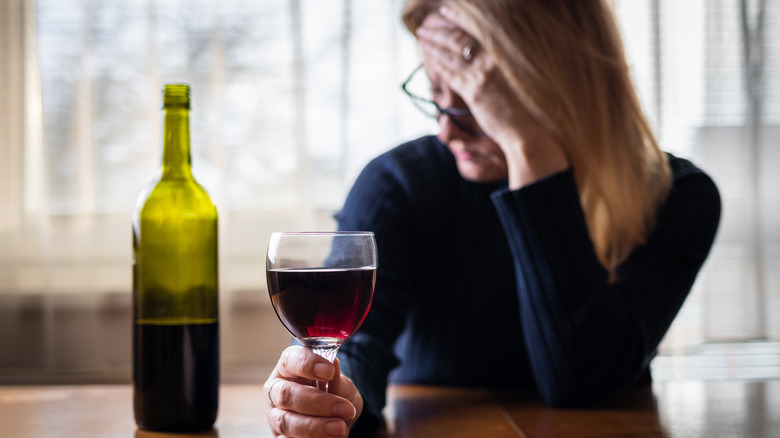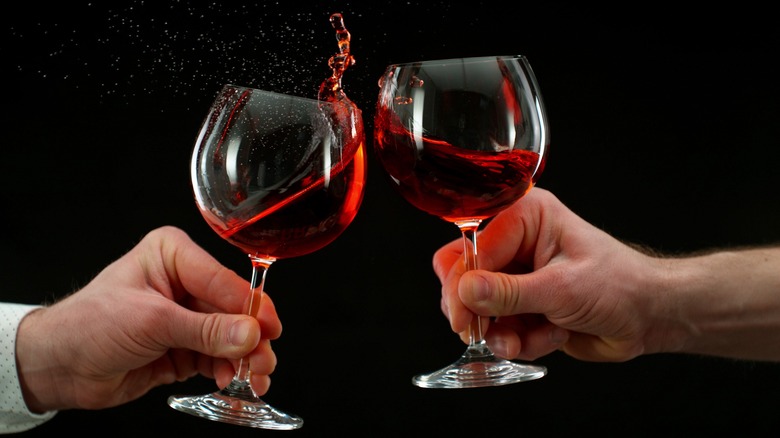The Scientific Reason Red Wine Gives People Headaches
Headaches, nausea, fatigue, and irritability are all symptoms of a classic hangover — a trade-off for a night of high-spirited drinking that may have you scrambling for emergency cures. Sometimes though, you can wake up with just as much of a killer headache but without a whole lot of drinks to account for it, save for a glass or two of red wine. If this is the case you may be experiencing what's known as a red wine headache, and there is a perfectly good explanation for it.
According to a 2023 study published in Scientific Reports, the cause is the plant flavonol quercetin — a pigment that is naturally present in several fruits, vegetables, and grains including grapes (and which increases with greater sun exposure and certain techniques of making wine). On its own, quercetin has impressive health benefits, which is why it's often consumed as a dietary supplement for its allergy-relieving, inflammation-reducing, and blood pressure-lowering properties (via Healthline).
According to UC Davis, when your body processes alcohol, quercetin can turn into a headache-inducing compound called quercetin glucuronide. It's a different form of the same flavonol that inhibits alcohol from breaking down and leads to a build-up of acetaldehyde, a toxin responsible for all those soul-crushing headaches.
Other sensitivities can also cause wine headaches
The traces of a faint headache can begin after just a few swigs of red wine, and unlike hangovers that typically unravel the morning after, a wine headache can unfurl within a half-your of drinking. So when it comes to red wine, it's not so much the quantity as it is the kind of alcohol that's to blame.
One possible culprit is sensitivity to the sulfites present in wine. Added as a preservative to protect vino's freshness, sulfites can trigger breathing-related side effects among those sensitive to it, which can in turn lead to headaches (via Healthline).
As well, anyone sensitive to histamine — a chemical present in grape skins — might also find themselves more prone to wine headaches. That being said, if it's this compound to blame, you'll find other histamine-rich foods such as aged cheese, salami, eggplant, and fish triggering the same sort of headaches.
Another reason for the pain could be the tannins that are present in greater quantities in red wines — the same compounds that give the drink its bitter astringency and complex flavor. As your body consumes tannins, it releases serotonin, which can sometimes lead to headaches. Other times, it could simply be that your body doesn't properly produce the enzyme that can inhibit the acetaldehyde toxin from accumulating — a possible culprit behind red wine headaches for nearly 40% of the East Asian population, according to the scientists at UC Davis.
Tips to avoid wine headaches
While it's good to know that those red wine headaches have a scientific explanation, the more pressing question here is maybe: What can you do about them? The golden rule of drinking is that prevention is always better than the cure, so it's wise to nip the headache in the bud before it even has a chance to fully manifest. Some tips: Never drink red wine on an empty stomach and make sure to gulp down some water first.
Lining your stomach with two cups of strong coffee may also prevent the subsequent headache — even better if it has a drizzle of honey to help digest the wine a bit more quickly. If you suspect tannins or sulfites to be the culprit for that pounding at the back of your head, consider your choice of wine more closely. Go for low-sulfite wines and lighter varietals that are low in tannins; for example, Pinot Noirs and Gamays.
If you notice a headache beginning to take shape, it's also a good idea to put that red wine down, rest in a dark room away from sunlight, and ice your head. Pain relievers like aspirin can help with particularly nasty headaches, though mixing them with alcohol requires some caution. In most cases though, water is your best friend: Drink it before your first sip of red wine, drink it between each glass, and drink it after you're done for the night.



